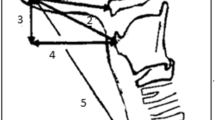Abstract
Introduction
The proper visualisation of the larynx is required for the diagnostic assessment and therapeutic intervention. The most significant challenges for surgeon is to visualise the anterior commissure of the glottis region. The aim of this study is to record the preoperative laryngoscore in patients posted for endolaryngeal surgery and to assess preoperative predictors for intraoperative difficult laryngeal exposure by correlating with preoperative laryngoscore.
Design
Prospective, Cross-sectional, Observational study.
Setting
Department of Otorhinolaryngology in a tertiary care teaching facility.
Subjects
150 patients were included with an endolaryngeal disease who were planned for surgery with age > 18yrs.
Methodology
In 150 subjects preoperative laryngoscore was calculated, which comprised 11 parameters including thyromental distance, mandibular prognathism, macroglossia, micrognathia, trismus, inter incisor gap, degree of neck flexion-extension, history of prior open-neck surgery or radiotherapy, upper jaw dental status, modified Mallampati score and body mass index in order to produce a total score out of a possible maximum score of 17. According to the anterior commissure visualisation all patients were categorised into five classes, ranging from class 0 to class IV during surgery. The laryngoscore parameters were assessed and compared statistically with five classes of intraoperative anterior commissure visualisation.
Result
Out of 150 patients 70 (46.6%) were having 3–4 laryngoscore, followed by 45 (30%) patients with 5–6 laryngoscore. Total 123 (82%) patient had class 0,1 and 2 intraoperative anterior commissure visualisation while 27 (18%) had class 3 and 4 visualisation. If laryngoscore was either less or equal to 5, 90% of the patients had excellent laryngeal exposure whereas only 10% of the patients had challenging laryngeal exposure. At univariate analysis, thyromental distance, degree of neck flexion/extension, and modified Mallampati classification were found statistically significant for difficulty of anterior commissure visualisation independently.
Conclusion
A sound, easy and valid preoperative laryngoscore may be significantly helpful in identifying intraoperative difficult laryngeal exposure. This may prevent inadequacy of surgery, abandon of surgery, intra operative complication, and medico-legal cases for laryngologist.
Similar content being viewed by others
References
Lungova V, Thibeault SL (2020) Mechanisms of larynx and vocal fold development and pathogenesis. Cellular and Molecular Life Sciences. Out;77:3781-95
Kawakita D, Matsuo K (2017) Alcohol and head and neck cancer. Cancer Metastasis Rev 36:425–434
5, Silver CE, Moisa II (1990 May-Jun) The role of surgery in the treatment of laryngeal cancer. CA Cancer J Clin 40(3):134–149
Steiner W, Ambrosch P, Rödel RM, Kron M (2004) Impact of anterior commissure involvement on local control of early glottic carcinoma treated by laser microresection. Laryngoscope 114(8):1485–1491
Sivaraj P (2017) Predictability of Difficult Laryngoscopy and Intubation using the Clinical and Radiological Imaging Study (Doctoral dissertation, Chengalpattu Medical College, Chengalpattu), vol. 4, no. 82, pp. 4825– 4829,
Ohno S, Hirano S, Tateya I, Kojima T, Ito J (2011) Management of vocal fold lesions in difficult laryngeal exposure patients in phonomicrosurgery. Auris Nasus Larynx 38(3):373–380
Arjun AP, Dutta A (2019) A study of application of preoperative clinical predictors of difficult laryngeal exposure for Microlaryngoscopy: the Laryngoscore in the indian Population. Indian J Otolaryngol Head Neck Surg 71(4):480–485
Kharrat I, Achour I, Trabelsi JJ, Trigui M, Thabet W, Mnejja M et al (2022) Prediction of difficulty in direct laryngoscopy. Sci Rep 06(24):10722
Singhal P, Bhandari A, Chouhan M, Sharma P, Sharma S (2009) Benign tumours of larynx-A clinical study of 50 cases. Indian J Otorhinolaryngol Head Neck Surg 61:26–30
New GB, Erich JB (1938) Benign tumors of the larynx: a study of seven hundred and twenty-two cases. Arch Otolaryngol 28(6):841–910
Nallathambi C, Yumkhaibam SD, Singh LJ, Singh TT, Singh IY, Daniel N (2016) Clinico-epidemiologic patterns of Laryngeal Cancer: 5-year results from a Regional Cancer Centre in northeastern India. Asian Pac J Cancer Prev 17(5):2439–2443
Kumar A, Sharma A, Ahlawat B, Sharma S (2014) Site specific effect of tobacco addiction in upper aerodigestive tract tumors: a retrospective clinicopathological study. ScientificWorldJournal 2014:460194
Baitha S, Raizada RM, Singh AK, Puttewar MP, Chaturvedi VN (2002) Clinical profile of hoarseness of voice. Indian J Otolaryngol Head Neck Surg 54(1):14–18
Kim WH, Ahn HJ, Lee CJ, Shin BS, Ko JS, Choi SJ, Ryu SA (2011) Neck circumference to thyromental distance ratio: a new predictor of difficult intubation in obese patients. Br J Anaesth 106(5):743–748
Piazza C, Mangili S, Bon FD, Paderno A, Grazioli P, Barbieri D, Perotti P, Garofolo S, Nicolai P, Peretti G (2014) Preoperative clinical predictors of difficult laryngeal exposure for microlaryngoscopy: the laryngoscore. Laryngoscope 124(11):25617
Mallampati SR, Gatt SP, Gugino LD, Desai SP, Waraksa B, Freiberger D, Liu PL (1985) A clinical sign to predict difficult tracheal intubation; a prospective study. Can Anaesthetists’ Soc J 32(4):429–434
Roh JL, Lee YW (2005) Prediction of difficult laryngeal exposure in patients undergoing microlaryngosurgery. Ann Otol Rhinol Laryngol 114(8):614–620
Author information
Authors and Affiliations
Ethics declarations
Conflict of interest
Nil.
Financial support – Nil.
Additional information
Publisher’s Note
Springer Nature remains neutral with regard to jurisdictional claims in published maps and institutional affiliations.
Rights and permissions
Springer Nature or its licensor (e.g. a society or other partner) holds exclusive rights to this article under a publishing agreement with the author(s) or other rightsholder(s); author self-archiving of the accepted manuscript version of this article is solely governed by the terms of such publishing agreement and applicable law.
About this article
Cite this article
Nautiyal, S., Kumar Agarwal, V., Bist, S. et al. Assessment of Preoperative Predictors for Difficult Laryngeal Exposure in Endolaryngeal Surgery. Indian J Otolaryngol Head Neck Surg 76, 490–494 (2024). https://doi.org/10.1007/s12070-023-04190-6
Received:
Accepted:
Published:
Issue Date:
DOI: https://doi.org/10.1007/s12070-023-04190-6




